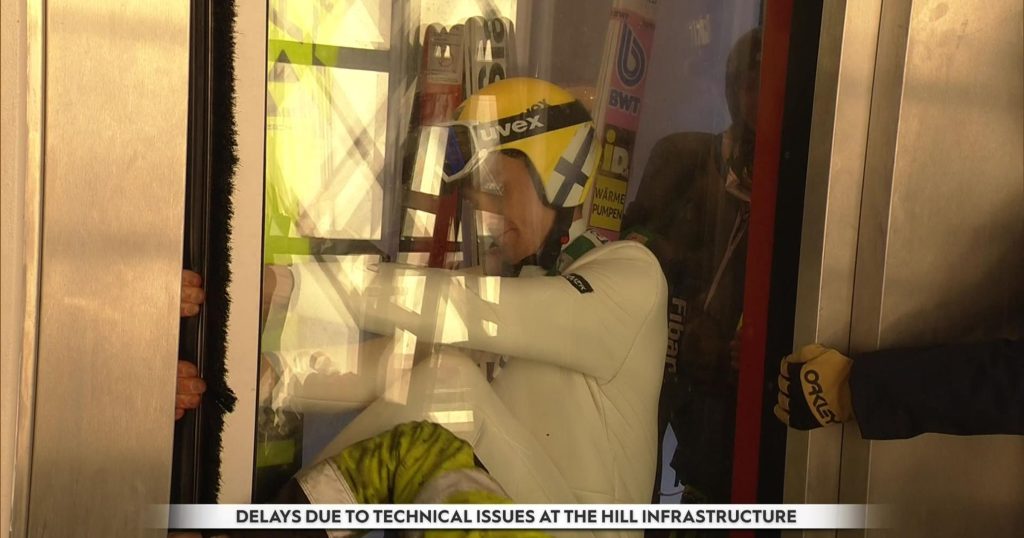The prestigious Four Hills Tournament, a cornerstone of the ski jumping world, took an unexpected and chaotic turn at the Garmisch-Partenkirchen leg when a group of athletes found themselves trapped in a malfunctioning elevator. This incident, though ultimately resolved without serious harm, injected a dose of real-world drama into the high-stakes competition, disrupting schedules, raising concerns about athlete well-being, and momentarily shifting the focus from sporting prowess to logistical mishaps. The athletes, primed for their jumps and carrying the weight of expectations, were abruptly confronted with an unnerving situation that tested their composure and resilience.
The incident unfolded just hours before the qualification round, a crucial stage in the tournament that determines who advances to the main competition. As the athletes boarded the elevator, intending to ascend to the jump tower, the machinery shuddered to a halt, trapping them in the confined space. The sudden stoppage triggered a wave of anxiety among the athletes, some of whom were already grappling with the pressure of competing at such a high level. The enclosed environment, combined with the uncertainty of the situation, amplified the psychological strain, potentially impacting their focus and performance. News of the incident quickly spread, creating a buzz of concern and speculation among fans, officials, and the media, turning a routine pre-competition period into a logistical and public relations challenge.
The immediate response from tournament organizers and emergency services was swift and coordinated. Recognizing the potential physical and psychological impact on the athletes, rescue crews worked diligently to extricate them from the malfunctioning elevator. While the exact duration of their confinement varied depending on the source, reports indicate the athletes were trapped for approximately 30 to 45 minutes, a period long enough to induce considerable stress and discomfort. The confined space, coupled with the uncertainty of the situation, undoubtedly created a challenging environment for the athletes, testing their mental fortitude and ability to manage unexpected adversity. The rescue operation, though successful, underscored the vulnerability of athletes to unforeseen circumstances and the importance of robust safety protocols at sporting venues.
The aftermath of the elevator incident rippled through the Garmisch-Partenkirchen leg of the tournament. The disruption to pre-competition routines and the psychological impact on the affected athletes necessitated adjustments to the schedule. Qualification rounds were delayed, throwing the meticulously planned timetable into disarray and requiring organizers to manage the logistical complexities of rescheduling and coordinating with broadcasters and spectators. The incident also highlighted the potential for unforeseen events to disrupt even the most carefully planned sporting events, emphasizing the need for flexible contingency plans. Beyond the logistical challenges, the incident raised concerns about the psychological well-being of the athletes.
The psychological impact of the elevator incident extended beyond the immediate confines of the trapped athletes. The incident brought into sharp focus the mental pressures faced by elite athletes, reminding everyone that even the most physically prepared competitors are susceptible to psychological stressors. The unexpected confinement, combined with the pressure of performing at a world-class level, could have potentially affected the athletes’ concentration, confidence, and overall performance. While some athletes were able to compartmentalize the experience and proceed with their jumps, others may have been more significantly impacted, highlighting the importance of providing athletes with access to mental health support and resources. The incident served as a reminder that athletic performance is not solely determined by physical prowess but is also deeply intertwined with mental resilience and emotional well-being.
The “elevator incident” at Garmisch-Partenkirchen, though relatively minor in terms of physical consequences, served as a potent reminder of the unpredictable nature of live sporting events. It exposed the vulnerability of athletes to unforeseen circumstances, highlighted the importance of robust safety protocols, and underscored the interplay between physical and psychological factors in athletic performance. The incident became a talking point of the tournament, demonstrating how a seemingly mundane technical malfunction can quickly escalate into a disruptive and potentially impactful event. The swift response of organizers and the resilience of the athletes prevented the incident from derailing the competition entirely, but it left a lasting impression, reminding everyone that even in the highly structured world of professional sport, chaos can reign at any moment. The incident also spurred conversations about the importance of mental health support for athletes and the need for organizers to be prepared for the unexpected. While the athletes ultimately returned to the competition, the experience undoubtedly left its mark, serving as a reminder of the myriad challenges, both physical and mental, that athletes face in their pursuit of excellence.














